Infalsificables of the Oficina (Impresora) del Gobierno - México
by Cedrian López Bosch
As mentioned earlier, as the Constitutionalist movement consolidated its power, it increased the needs for resources, as well as fractional currency, to pay the troops and settle daily commercial transactions. Therefore, the decree of 3 April 1916 not only doubled the amount of the issue but included the denominations of one and two pesos, omitted in July 1915. On 6 April it was reported that the Secretaría de Hacienda had told the Oficina Impresora de Estampillas to suspend all paper money issues, in order to concéntrate on the preliminary work for printing the new $1 and $2 notesLas Noticias, Querétaro edition of El Demócrata of México, 11 April 1916.
Considering that Carranza’s government intended to print the notes in Mexico, shortly after the issue of this second decree, the Chief of Engraving of the Stamp Printing Office, Fernando Fernández, was instructed to acquire a printing machine from the United States“Será adquirida una máquina notable para imprimir billetes”, El Pueblo, Año III, Tomo I, Núm. 540, 20 April 1916. However, this cannot have been the machine used in this issue, because several later newspaper articles report its arrival was still expected; one article said that it was similar to the presses of the ABNC, “Los billetes del Banco Único serán hechos en México”, El Pueblo, Año III, Núm. 1018, 25 August 1917 another that it came from the Bureau of Engraving and Printing“Llegó a Laredo magnifica maquinaria para la impresión de billetes, siendo idéntica a la que posee la American Bank Note Ca. de Nueva York”, El Pueblo, Año III, Núm. 1018, 25 August 1917; “Llegó la maquinaria adquirida por el gobierno”, El Pueblo, 27 October 1917; “Las imprentas del gobierno quedarán instaladas en Palacio Nacional”, El Pueblo, Año III, Núm. 1163, 18 January 1918, “lnstalación de maquinaria moderna”, El Informador, 4 January 1918.
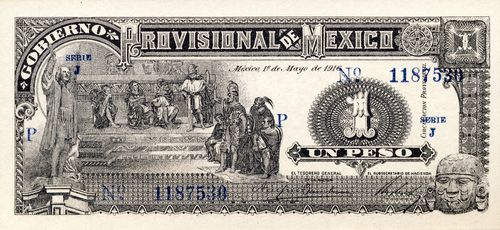

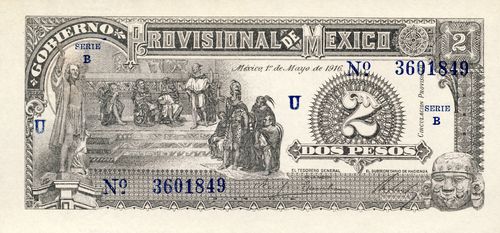
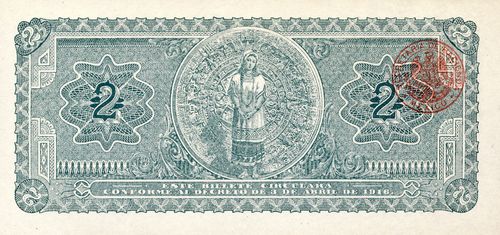
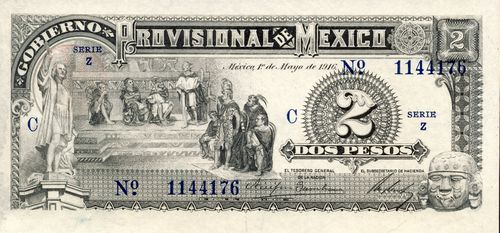
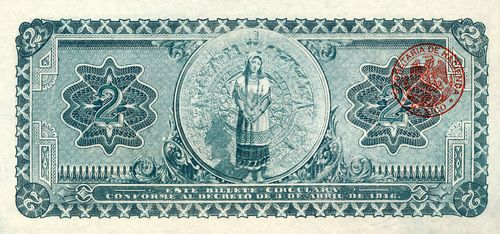
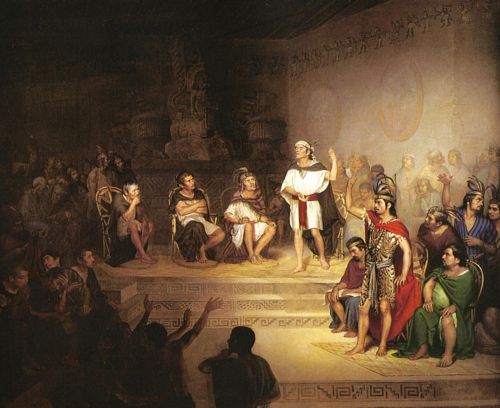 On the face, the one and two pesos notes show on the left a reproduction of the Monument to Christopher Columbus by Charles Cordier, erected in 1877 in the Paseo de la Reforma in Mexico City; at the center, as reported by the newspaper El Pueblo, “an engraving of the Tlaxcala Congress at the time when the situation of that republic (sic) was being debated when the conquistadors led by Hernán Cortés invaded America; “Se están Imprimiendo ya los billetes de a $1.00 y $2.00, de la nueva emisión”, El Pueblo, Año III, Tomo I, Núm. 493, 4 March 1916 a replica of an 1875 oil painting by Rodrigo Gutiérrez, who participated in the Universal Exhibition of Paris in 1889, and which is now in the National Museum of Art, and in the lower right corner a sculpture of the head of the Aztec goddess of the moon, Coyolxauhqui, found in 1830 in the excavations of the old convent of La Concepción, part of the Templo Mayor, taken at the beginning of the 20th century to the National Museum and exhibited today in the National Museum of Anthropology and History. The reverse, according to a contemporary article, “represents the Aztec Calendar, in front of which is the Malintzi[n]” ibid. franked by two rosettes with the denomination.
On the face, the one and two pesos notes show on the left a reproduction of the Monument to Christopher Columbus by Charles Cordier, erected in 1877 in the Paseo de la Reforma in Mexico City; at the center, as reported by the newspaper El Pueblo, “an engraving of the Tlaxcala Congress at the time when the situation of that republic (sic) was being debated when the conquistadors led by Hernán Cortés invaded America; “Se están Imprimiendo ya los billetes de a $1.00 y $2.00, de la nueva emisión”, El Pueblo, Año III, Tomo I, Núm. 493, 4 March 1916 a replica of an 1875 oil painting by Rodrigo Gutiérrez, who participated in the Universal Exhibition of Paris in 1889, and which is now in the National Museum of Art, and in the lower right corner a sculpture of the head of the Aztec goddess of the moon, Coyolxauhqui, found in 1830 in the excavations of the old convent of La Concepción, part of the Templo Mayor, taken at the beginning of the 20th century to the National Museum and exhibited today in the National Museum of Anthropology and History. The reverse, according to a contemporary article, “represents the Aztec Calendar, in front of which is the Malintzi[n]” ibid. franked by two rosettes with the denomination.
There are three notes with this design, one of one peso and two of two pesos, all of them with the imprint on the face “Oficina del Gobierno - México“. One of each denomination was printed by lithographic process, with the legend “circulación provisional”. The ones of one peso show the series J, and those of two pesos the series A and B. The two pesos was replaced by another similar one, theoretically printed with plates engraved in steel, although the differences are not very remarkable, without the said legend and with the Z series. The faces are printed in black - although some of two pesos are brown - with numbers and series in blue, while the reverse of those of one peso is coffee with a seal of the Ministry of Finance in blue, and of two pesos are green with a red seal. In addition to color and denomination, another difference between both notes is in the backgrounds; The one peso have small squares with a “1”, franked by this same figure in the four cardinal points and the word “UNO” horizontally and “Mexico” vertically. Those of two pesos have smaller microprinted texts with the word and the number “2”
The El Pueblo article attributed the design and engraving to Fernando Fernández and mentioned an additional denomination in preparation, 50 centavos, unknown until now. The Patrimonial Collection of the Stamp and Seal Printing Workshop has a model of this denomination.
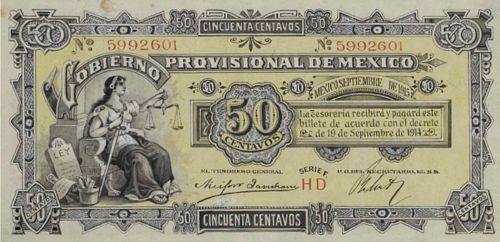
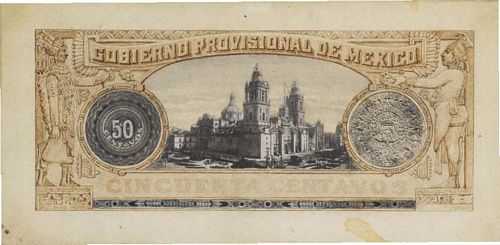
Although the reference to the decree of 19 September 1914 suggests that this model had been prepared to complete the issue of the Provisional Government of Mexico (or Veracruz), the date September 1915 seems to indicate that it was intended to be used at a later date, possibly when the next issue was prepared. The three denominations should have been presented by the Undersecretary Nieto to Carranza CEHM, fondo XXl-4, telegram of Rafael Nieto to Carranza, 18 March 1916 but only the one and two pesos were issued.
The design of the peso note was modified even before it was put into circulation“El día 12 del mes entrante estarán ya resellados y contraseñados los billetes de la nueva emisión”, El Pueblo, Año III, Tomo I, Núm. 521, 1 April 1916.
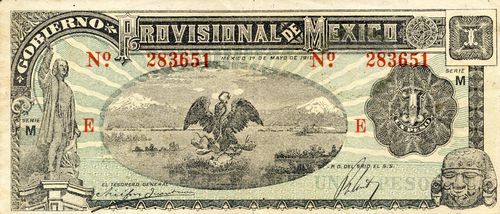

The scene of the so-called Tlaxcala Congress was replaced by the central vignette used in the issues of the Provisional Government of Mexico and Veracruz, that is, “the marble peaks of the legendary volcanoes, the diaphanous mirror of the lake of Cuauhtémoc and the symbolic queen of the air, preying on the filthy reptile"”Billetes Jarochos”, El Pueblo, Año I, Tomo I, Núm. 68, 13 December 1914 as El Pueblo poetically described the legend of the foundation of Tenochtitlan and the rosette with the name moved to the right , while the date, signatures, decree and the Coyolxauhqui remained the same, the main ink was black and the backgrounds green-blue with fine lines and in part of the underprint the legend “UN PESO” microprinted in wavy form. On the back appears a 1908 silver peso with the Phrygian cap and the denomination “1” on the sides on two rosettes and in the four corners in a blue tone - although several shades are distinguished - and the seal of the Ministry of Finance in green. For this issue ten series from L to U are known, none of them with the imprint of the printing house at the bottom. Although the previous design“los billetes de uno y dos pesos, de la nueva emisión. Probablemente empezaran a circular desde la decena próxima, pues con ese fin, se trabaja activamente”, El Pueblo, Año III, Tomo I, Núm. 590, 17 June 1916 was still reproduced in the press in mid-June, both versions would have reached circulation.
On 10 March 1916 Charles Blackmore, the American Bank Note Company's Resident Agent in Mexico City, had reported that a new issue of one and two peso notes was to be engraved and printed by the Mexican Government in the Government Bureau of Engraving and Printing. He was very surprised at the news as he had understood that the ABNC had been promised all the work for the new issue. On 20 March New York replied “If we have been advised correctly the paper that has been ordered by the Government - and which I stated to you in my letters of January and February, is Old Hampshire Bond; and if the Government really intends to print these two denominations on this paper, it will make quite a difference in their usage when put in circulation, and it would be well for you to assure yourself by going to the Bureau of Engraving and Printing to ascertain whether these notes are to be entirely steel engraved - that is, face and back.
It is true that we had been promised all the work for this new issue - so much so that even today we have before the Government several propositions to that effect; but between you and me, I have been given so many of them that I am beginning to be somewhat doubtful as to what the outcome might be.
Last Saturday we learned from a very good source that a Commission from Mexico was here in New York to buy steel plates and steel presses. Upon further inquiry I find that these are being ordered by the Bureau of Engraving with the idea of printing their own stamps and small steel work, but not Bank Notes. The Government may have decided however to print their own 1’s and 2’s owing to low rate of exchange, which will make the notes printed by our Company too expensive.
You had better try to investigate this new installation of machinery in the Bureau of Engraving and report as fully as you can on the subject.”ABNC, folder 210, Republic of Mexico (1915 (Feb) – 1916 (June).
On 3 April Blackmore sent a newspaper cutting that the models for these notes had already been prepared. He was making inquiries as to what work is being done in the Government Bureau of Engraving & Printing, also what new machines were being installed and the quantities of paper which had been received from the States, and for what use this paper has been ordered,
In the meantime, Alfredo Caturegli told the ABNC that the $1 and $2 printed by the Parsons Trading Company, would be kept in circulation for the time being. “We would naturally think that an official like the Financial Agent would know exactly what is going on; but I think he is wrong, and I feel almost certain that the Mexican Government has decided to print these two denominations in their own plant.” “I suppose the reason why the order for the One and Two Pesos was not placed with us so as to have a uniform issue of paper currency is due to low rate of exchange now existing in the Republic, as in Mexican money it would make the bills cost the Government in the neighbourhood of 240 Pesos per 1000, and that for a small size note.”
El Pueblo reported the printing of 300,000 pesos a day“Serán lanzados a la circulación los nuevos billetes de uno y dos pesos”, El Pueblo, Año III, Tomo I, Núm. 588, 15 June 1916 and praised the work, stating: “As regards quality and artistic finish, both in terms of drawing and engraving, it exceeds that of North American manufacture. The same paper is truly infalsificable.”ibid.. However, the ABNC’s judgement was that the $2 note “is very bad specimen, and does not come up to what the Government has promised to give to the public. Let us hope that this will create quite some dissatisfaction among the public and the banks, and that they will have to give what they promised to do – that is an “Infalsificable” note.”ABNC, folder 210, Republic of Mexico (1916 (July) – 1935). Years later, comparing the engraving of the Aztec Calendar of the ABNC notes and the Government Printing Office, Fernando Fernández himself highlighted the nationalist character he had managed to get printed “El arte del grabado retrospectivo aplicado a los valores mexicanos constituye una novedad y honra al obrero nacional”, El Nacional, 19 January 1917.
In addition, cartones of 5, 10 and 20 centavos were also produced. Those of five centavos had the same design as previous ones, but instead of red they were orange, with a Roman five superimposed on the image of Justice; those of ten centavos of a more intense blue with a Roman ten on the obverse and those of 20 centavos were printed on lead colored paper, with the Piedra del Sol on the face and its value and the legend ‘Gobierno Provisional’ on the reverse“Seguirán circulando ros billetes de uno y dos pesos y la moneda fraccionaria”, El Pueblo, Año III, Tomo I, Núm. 546, 30 April 1916. They all had a stylized security monogram with the letters GCM (Gobierno Constitucionalista de México).
I suppose that hoping that the small notes would be quickly ready, on 3 May 1916, Secretary Cabrera proposed to the Monetary Commission to modify the range of the denominations that made up the 500 million of the 3 April decree , increasing those of one peso to 100 million; those of two pesos to 80 million; those of five and ten pesos to 70 million, while decreasing those of 20, 50 and 100 pesos to 60 million each AGN, SC226 Comisión Monetaria, Caja 69, Libro de Actas No.1de la Comisión Monetaria, Acta #4 , 3 May 1916. Although there were no objections from the members, it seems that the suggestion was not presented to Carranza nor was the decree modified. To date, I have only been able to find a reference to the amount printed in Carranza’s report to the Congress on 15 April 1917, where it mentions 90 million, although this figure could include the fractional notes as well. The following table presents an estimate based on the numbers of the examples that I have been able to observe.
| Estimated quantities produced by the Oficina Impresorabased on the serial numbers from various collections | |||||
| Series | from | to | Estimated total number |
total value |
|
| $1 | J “provisional” | 1 | 1500000 highest number recorded 1227827 | 5,000,000 | $ 5,000,000 |
| L-U | 1 | 5000000 | 50,000,000 | 50,000,000 | |
| $2 | A-B “provisional” | 1 | 5000000 | 10,000,000 | 20,000,000 |
| Z | 1 | 5000000highest number recorded 2955812 | 5,000,000 | 10,000,000 | |
| Total | 70,000,000 | 85,000,000 | |||
ABNC correspondence
On 10 May Blackmore, the ABNC's Resident Agent, reported that it was widely rumoured that commerce in Mexico City refused to accept the new one peso notes as they were so badly engraved and printed. He suggested showing the notes to the representative of the de facto Government in New York in charge of supervising the printing of the Government notes (Caturegli) and endeavour to secure an order from him for the one and two peso notes. “The one and two peso notes are now used as fractional currency and if there was any serious opposition against receiving the new 1 and 2 peso notes I see no reason why we could not submit prices and specimens to the de facto Government on a note measuring about 3 1/2” x 2” with one litho and one steel printing on face and one steel printing on back (or if necessary to reduce the prices, one litho printing on back). You should be able to furnish such a note, if the size and designs were left entirely to your judgement, at a very reasonable price, considering the large quantities needed - 80,000,000 of the ones and 70,000,000 of the two peso notes.
A note of about this size would be very convenient and it would at the same time meet every requirement.
In order to be prepared for any emergency I would like you to cable me what sized note you would suggest and the price, and in addition it would be as well if you sent me a face and back model of the note you figured on. Of course you will understand I only ask for this information so as to be prepared in case I am called upon to use it at a moment notice. I do not in any way wish to upset any arrangement you are making at your end, but I may have to “strike whilst the iron is hot” and it would never do to loose valuable time in cabling and writing.
It may interest you to know that new issue is undated, with the exception of date of the decree mentioned on the back - The seal of the Finance has been added to the back.
Furthermore there is no mention as to who will pay the notes; the Veracruz notes states that “La Tesorería Recibirá y Pagará este billete de acuerdo con el decreto de 10 de Septiembre de 1914” - the new issue as you know states that “Este billete circular conforme al decreto de 21 de Julio de 1915”. I have not got a copy of the decree of 21st of July 1915 when directly it makes mention in the decree who is responsible for the notes, but a slight omission of this kind causes a certain amount of comment on the path of the public.”ABNC, folder 210, Republic of Mexico (1915 (Feb) – 1916 (June)
On 11 May Blackmore sent New York a specimen of the new one peso notes, “No comment is necessary”, and on 22 May New York replied that the new notes “certainly are a disgrace and should not be considered a part of notes which we furnish them for this issue.”ibid.
On 24 May Claudet reported that he had given Caturegli the $1 note and “he is fully disgusted with them, although he is powerless to do anything. In accordance with your suggestion, we will therefore prepare a model of the One and Two Pesos Notes of the small size, measuring 1-3/4 x 3-23/32” and 2 x 4”. This is for work only.
We will cable you some time today the price at which you may offer these notes, although I very much doubt whether this will be acceptable to Sr. Cabrera, as I fear the notes are much too small. You can try it, anyhow, and see whether we cannot interest him in having all the bank notes uniform in quality, and not have these wretched ones they have in circulation now. In this connection it is my intention to write a personal note to Sr. Cabrera (not making it official) calling his attention to what we would like to do for him for his One and Two Pesos Notes. I will give you a copy of that letter, and think it will be well to see whether you can interest him in these new notes.”
So, on 26 May, Claudet wrote to Cabrera “If you will allow me, I would like to be permitted to express - not officially, but as a friend - the great danger of such a note, having no protection whatsoever, and which can be reproduced by an ordinary printer. and certainly such notes would affect the whole issue and disturb the public confidence that your Administration has been trying to obtain but bringing out a uniform and well protected issue.
I can really understand that for economical reasons you probably had to have recourse to a cheaper note, owing to the very low rate of exchange; and the 1 and 2 Pesos notes being small denominations, you did not want to incur any unnecessary expense. After all, is it economy and worth while (the decreed value of the peso of the new issue being worth 20 centavos Mexican Gold) to place in circulation a note which I feel sure can only create discontent and fear of numerous counterfeitings. As we all know, the smaller denominations find their place among the poorer class people who, the instant counterfeitings appear, will become very suspicious and probably affect the general issue, and therefore disturb the purpose which the Government has been trying to obtain from the nation - that is, to establish the confidence and improve the rate of exchange by a new issue.
If you will consider the usage that this new One Peso note would have, once in circulation, it is my firm belief that the ones which we had the honor to furnish your Government will outwear the One and Two peso Notes over time.
In view of all these facts given you above, I have thought that I might interest you in a smaller note to be engraved and printed similar to the issues that we have just completed, and which would be more in keeping with the general issue; and for this reason I have taken the liberty to instruct our Resident Agent in Mexico – Mr. Charles T. Blackmore, to whom I will forward models in a few days, to interview you and discuss the subject with you.
On 5 June the ABNC forwarded models for the $1 and $2 notes.
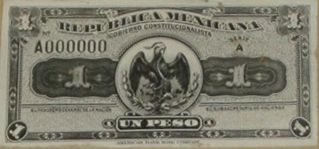
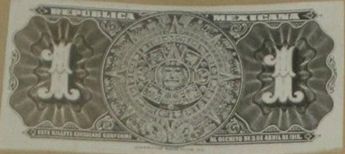
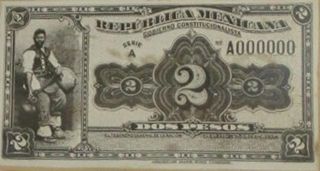
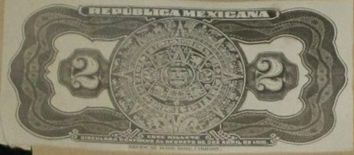
These models, with the order number 7058 and date 1 June 1916, refer to the decree of April 1916, as do the notes printed by the Oficina Impresora de Gobierno de México. The vignettes are similar to those used on other Mexican notes from this time, such as an unissued 50c Banco de Nuevo León note.
In June Harry H. Meyer, the Manager, Paper Department, of the National Paper & Type Company approached the ABNC as the former was being offered the order to print the 1 and 2 Pesos notes which the Mexican Government was unable to execute; and "we naturally could not afford to throw down their offer". After two weeks’ negotiations, on 11 August, the ABNC gave them a quotation for either 50,000,000 or 100,000,000 notes (which would be the same that the ABNC would give to the Mexican Government in case the latter should approach them directly or through their agent). However, on 22 August the National Paper & Type Company reported that its negotiations with the Mexican Government had fallen through and suggested that the ABNC negotiate directlyABNC, folder 210, Republic of Mexico (1916 (July) – 1935).
On 13 June Blackmore, in reply to a query about the difference between the heading of the $1 note and the ABNC issues, wrote “[m]y opinion is, that as the old Veracruz issue of notes had as a heading “Gobierno Provisional de México” and the vignette of the two snow mountains with the eagle landing on a cactus plant in the middle of the lake. the government Bureau of Engraving and Printing saved money and time by using the same heading and vignette, for if what Mr. Cabrera says is true the new one peso note is only provisional and they are preparing new models for the one and two peso notes.”
On 9 June Blackmore called on Cabrera. “As you know the one peso notes printed by the Government are already in circulation, these notes Sr. Cabrera informed me were or rather are only provisional and they have already prepared the engraving for the new note they intend placing in circulation, They have also in course of preparation the engravings for the two peso notes. … the Minister asked me to call upon him as soon as I receive the models you are sending me. He asked that the whole matter be left pending until I had the models to show him.
I have to advise you that the models have this very moment being delivered. I will therefore close this letter and make arrangement to see the Finance Minister without further loss of time, advising you, by cable if necessary, the results of my interview.”
On 15 July Blackmore reported that Cabrera had told him that the reason he could not give the ABNC the order was that the prices were too high, and that it would be too great an expense for the government to place the order abroad. “But as this letter came just at the time that the relations between the State and Mexico were at a critical stage it gave me the impression that, in addition to the reasons he gave me, the international situation might have something to do with our not getting the order.” After several attempts on 27 July Blackmore had an interview with Cabrera, who reiterated his decision. “But I have not lost confidence we will, in the end, receive this order; for notwithstanding the fact that the new one and two peso note, which are being prepared by the Government in their Bureau of Engraving and Printing, were to have been placed in circulation at the beginning of this week, I have heard that the commerce in general will refuse to accept the new notes on the excuse that they are not, as is claimed by the Government, “infalsificables”. For in this connection the Government, through the press, have claimed that the new notes will be equal in every respect, in class of workmanship and in protection against falsifications, to the notes furnished by the American Bank Note Company.
In addition to this I understand that these new notes have not been placed in circulation as was promised. And further if the government persists in printing their own notes it will take them at the very least five years to complete the whole issue.”
The new $1 and $2 notes were put into circulation on 24 July”El lunes proximo se lanzaran a la circulacion los billetes por valor de uno y dos pesos: la Tesoreria General de la Nación sera la encargada de lanzar al mercado el nuevo papel infalsificable”, El Democrata, 20 July 1916.
On 16 August Blackmore wrote “This morning … I called on the Minister, Lic. L. Cabrera, and although he was not in his office when I arrived I was ushered in when he returned and he received me most cordially. I informed him that I had heard that Waterlow were making a bid for the one and two peso notes and he told me that he would in no case consider any outside bids and that he intended to continue printing the one peso notes in his (the Government’s) printing Office, but should he at any time have to place an order with any outside firm he would not hesitate in placing the order with the A. B. N. Co. This he repeated several times.”ABNC, folder 210, Republic of Mexico (1916 (July) – 1935).
On 28 August Blackmore sent one of the new two peso notes which have at last been placed in circulation. “This is still a further proof of the inability of the Government to print its own notes, further comment on my part is unnecessary.”
On 20 October Blackmore sent the ABNC three specimens of the two peso note. “The colours on the back are, as you will see, quite different in shades of green. The trimming of one of the notes is very bad , though I cannot say for certain if this is how it left the Government Printing Offices or if some person cut the edges after it was in circulation. As on the one peso note the latest issue of the two peso note also bears the words “Circulation Provisional”, the first issue of $2.00 notes did not have these words printed on them.
I am sending you these notes as you may wish to see Mr. Cabrera about the issues; calling his attention at the same time to the bad work the Government Printing Office is turning out.” ABNC, folder 210, Republic of Mexico (1916 (July) – 1935). On 1 November the ABNC replied “Mr. Green would like you to obtain, if you can, 25 specimens each of the 1 and 2 Peso notes, if possible, half of them printed from steel and the others by typographical process. - This with the idea of using them in foreign countries for advertisement, through our representatives, showing that certain Governments have attempted the printing of their own bank notes, and this has been the result.
I showed these specimens to Mr. Cabrera last week. He told me they were issued only temporarily. He did not seem to pay very much attention to the poor workmanship of these notes, but said that exchange is down so very low now, it would cost them more to have these notes printed by us than the money is really worth. He simply considers these 1 and 2 peso notes as fractional issues.”
